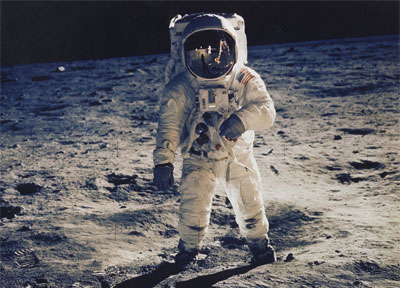Vision 2069by Vid Beldavs
|
| NASA represented massively organized innovation to achieve Kennedy’s vision of landing on the Moon and returning astronauts to the Earth within a decade. Now we need massively organized innovation matching the capabilities and challenges of our age. |
Now the world is eager for another grand vision. Such a vision can be built on the achievements of the past. The International Space Station is one of the greatest examples of international cooperation in human history and itself is deserving of the Nobel Peace Prize. The technologies and regime for international collaboration developed with the ISS can be built upon as a stepping stone towards bases on the Moon as well as other infrastructure on the Moon and in lunar orbit. Such infrastructure would dramatically lower the cost of going further into space. It would also create opportunities to do much more in space.
NASA represented massively organized innovation to achieve Kennedy’s vision of landing on the Moon and returning astronauts to the Earth within a decade. Now we need massively organized innovation matching the capabilities and challenges of our age. A return to the Moon to fully understand it and to develop ways to utilize lunar resources to build infrastructure and industrial facilities in space is a goal of comparable scope for our age to the first Moon landing 45 years ago.
Humanity’s population may nearly double by 2069, the year that will mark the 100th anniversary of the first Moon landing. Among the grand challenges facing humanity are obtaining water and other natural resources for a population of about 12 billion people. But, of possibly greater significance is that there is work for these people when machines and other automated systems will be able to do most work done by humans today. President Kennedy’s speech on September 12, 1962, may have answers for this challenge.
We choose to go to the Moon in this decade and do the other things, not because they are easy, but because they are hard, because that goal will serve to organize and measure the best of our energies and skills, because that challenge is one that we are willing to accept, one we are unwilling to postpone, and one which we intend to win, and the others, too.
Returning to the Moon to reenact Apollo 11 would be easy. Creating industrial capacity and infrastructure in space involving significant international collaboration would be very hard and push innovation across all human concerns. Doing hard things demands innovation and human skills. We need a 2069 vision that points to an industrialized Moon with large-scale facilities to meet needs on Earth as well as of a growing population of people working and living in space. To achieve Vision 2069 we need to extend the ISS partnership to start construction of the first international Moon base by 2019. That would be a fitting memorial to the NASA space program, whose enabling legislation, the Space Act of 1958, states:
The Congress hereby declares that it is the policy of the United States that activities in space should be devoted to peaceful purposes for the benefit of all mankind.
| The NASA of the 1960s is not what is needed by 2019. |
The NASA of the 1960s is not what is needed by 2019. Much more capability will be needed by 2069. If there is large-scale infrastructure development in space and on the Moon, it will require significant international cooperation as well as major roles for commercial business. What’s needed now is a way to massively organize innovation to address multifold, multidimensional, and multinational problems with a major science and technology component. A start would be for President Obama to propose the International Lunar Decade aimed at understanding the Moon and its resources and to develop the international regime necessary for commercial exploitation of those resources. NASA could be the organization to drive innovation and provide international leadership with private industry providing much of the capital with pump priming coming from a long-range Lunar Development Fund.
President Obama could still have a comparable role to President Kennedy in the next 50 years of space exploration and development. All that is needed is a vision of what is possible that is grounded in good science and technological capabilities, but that is not limited by short-term political calculations.
